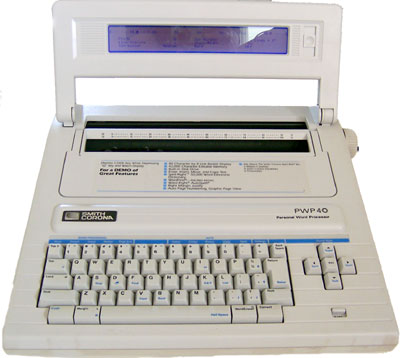I allowed them to write anything they wanted on a 4x6 card for the mid-term and final exams but I provided precious few resources. Printed books and the library drove education.
It was, indeed, a time before the interwebs. I had only seen a cellular telephone on TV and I was still using yellow chalk on a dark green blackboard. The souped up typewriter called a Word Processor that had served me well in college (thanks, Kendall) was still producing most of my worksheets for class. It was leaps better than the typewriter that my parents used when they were in college, but quite weak compared to what I have now.
Smith Corona Word Processor
Time and technology have revolutionized our world. Every teacher was issued a laptop years ago. We all have iPads now (but they're still not flash or java compatible). The internet exists and is easily accessed not by plugging in to the network, but with a simple wifi password. I tweet, blog, youtube and am the proud owner of six email addresses.
All my students have cell phones. These tiny devices, now most often smart phones, are status symbols and kids classify and ridicule each other on the basis of the quality of their machines.
So I give them this:
It has all the equations and constants and conversion factors they will need and they learn to use it well. I don't want them using precious brain space just to memorize facts that they can find in seconds using a pocket device.
It turns out that my Honors Physics students learn the important equations anyway just by using them often. Instead of focusing on tedious memorization, however, their minds are freed to contemplate and analyze. It's like the engineering certification test that some of my friends took senior year of college. They took stacks of textbooks and notebooks. Their job was to solve tough problems on a one day test using whatever resources they desired.
That engineering test had it right. In this modern world of easy access to information, let's provide the students with all the facts we can. Then they can do the tough work of interpretation and analysis.




Though an unreliable source...and I know nothing of the actual details of the "study" (and that word should be used lightly these days)...I still think this passes the smell test and is pretty interesting regarding memory:
ReplyDeletehttp://www.nytimes.com/2011/07/15/health/15memory.html?_r=1&
Those 6 pages, by the way, look remarkably similar to the sheets I took in to pass the PE exam. It was humorous to watch people with trunkloads of books. (I had my binder and two reference books). I wondered then how they could possibly find time to actually find the information that was relevant. I think it was three minutes per problem for the 1st four hours. And six minutes per large problem in the 2nd four hours.
Perfect. Thanks for the link and for a better explanation of the test than I could give.
ReplyDelete